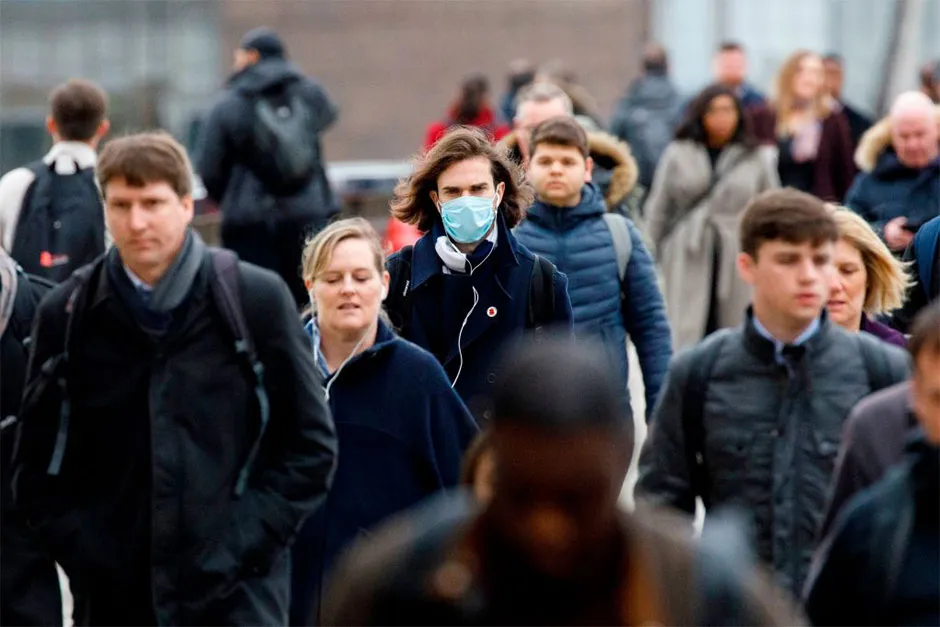The widespread use of face masks keeps the coronavirus reproduction number below 1.0, and prevents further waves when combined with lockdowns, new research suggests.
A modelling study from the universities of Cambridge and Greenwich indicates that lockdowns alone will not stop the resurgence of COVID-19.
Researchers say even homemade masks with limited effectiveness can dramatically reduce transmission rates if worn by enough people, regardless of whether they show symptoms.
Read more about the spread of COVID-19:
- Coronavirus: reducing distance to one metre increases transmission risk
- COVID-19 asymptomatic in over 80 per cent of cases, cruise ship study finds
Lead author, Dr Richard Stutt, part of a team that usually models the spread of crop diseases at Cambridge’s department of plant sciences, said: “Our analyses support the immediate and universal adoption of face masks by the public.
“If widespread face mask use by the public is combined with physical distancing and some lockdown, it may offer an acceptable way of managing the pandemic and re-opening economic activity long before there is a working vaccine.”
The coronavirus is transmitted through airborne droplets that get exhaled by infectious people, particularly when talking, coughing or sneezing.
For the latest study, researchers worked to link the dynamics of spread between individuals with population-level models, to look at different scenarios of face mask adoption combined with periods of lockdown.
In the UK, the approach to face masks should go further than just public transport
Prof John Colvin
The modelling included stages of infection and transmission via surfaces as well as air.Researchers also considered negative aspects of mask use, such as increased face touching.
The reproduction number, or R number, is the number of people an infected individual passes the virus onto, needs to stay below 1.0 for the pandemic to slow.Experts say the R number in the UK is currently 0.7-0.9.
The study, published in the Proceedings of the Royal Society A, found that if people wear masks when in public, it is twice as effective at reducing R than if masks are only worn after symptoms appear.
In all modelling scenarios, researchers found routine face mask use by 50 per cent or more of the population reduced COVID-19 spread to an R less than 1.0.This flattened future disease waves and allowed less-stringent lockdowns.Viral spread reduced further as more people work masks when in public.

According to the study, 100 per cent mask adoption combined with on/off lockdowns prevented any further disease resurgence for the 18 months required for a possible vaccine.
The models suggest that – while the sooner the better – a policy of total face mask adoption can still prevent a second wave even if it is not instigated until 120 days after an epidemic begins.
Researchers say masks that only capture 50 per cent of exhaled droplets would still provide a “population-level benefit”.This was even if they quadrupled the wearer’s own contamination risk through frequent face touching and mask adjustment – a highly unlikely scenario.
The researchers say homemade masks primarily reduce disease spread by catching the wearer’s own virus particles, whereas inhaled air is often sucked in around the exposed sides of the mask.
Read more coronavirus news:
- BAME women account for more than half of pregnant COVID-19 hospital admissions
- Coronavirus: manufacturing begins on 'millions of doses' of the Oxford vaccine candidate
Professor John Colvin, coauthor from the University of Greenwich, said: “There is a common perception that wearing a face mask means you consider others a danger. In fact, by wearing a mask you are primarily protecting others from yourself.
“Cultural and even political issues may stop people wearing face masks, so the message needs to be clear: ‘my mask protects you, your mask protects me’.
"In the UK, the approach to face masks should go further than just public transport. The most effective way to restart daily life is to encourage everyone to wear some kind of mask whenever they are in public.”
How can I protect myself from the coronavirus when shopping?
You’ll have seen signs in your local supermarket advising you to keep two metres from others while moving around the store. This is key to reducing your chances of catching the virus while shopping.
The coronavirus SARS-CoV-2 is spread through respiratory droplets that leave our mouth and nose when we cough, sneeze, or sometimes even talk. The droplets sprayed out by an infected person will contain the virus, which could then enter your body via your mouth, nose or eyes (this is why you shouldn’t be touching your face).
Respiratory droplets don’t usually travel more than one metre, so by keeping two metres from others, you’ll reduce the likelihood of being in the firing line. To make it easier to keep your distance, try to shop during off-peak hours, choose a store that’s limiting the number of people who can be inside at any one time, and use self-checkout if you can.
Keeping your hands clean is the other main thing you can do. If possible, wipe the trolley or basket handles with a disinfectant wipe when you arrive at the store. When you get home, wash your hands or use hand sanitiser before and after unpacking your bags.
A US study found that the coronavirus can survive for up to 24 hours on cardboard, and up to three days on hard, shiny surfaces such as plastic, so wiping down your purchases with a disinfectant spray or a soapy cloth before you put them away is another good habit to get into.
Read more: